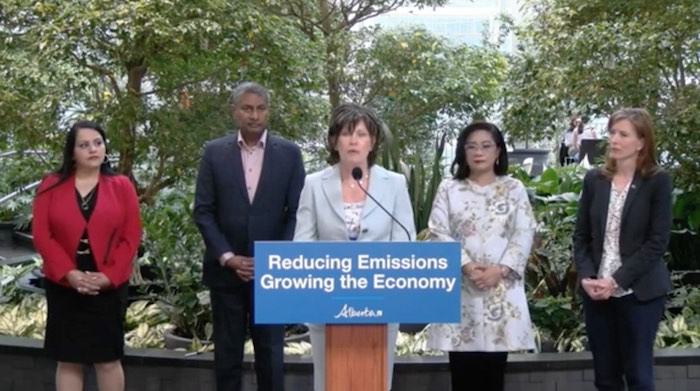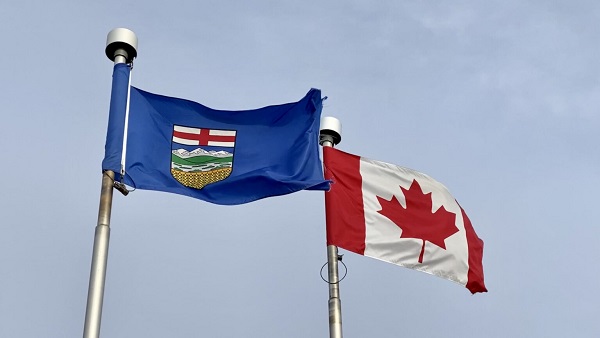Alberta
Province will balance the economy and the environment – Emissions Reduction and Energy Development Plan

Balancing the economy and the environment
Alberta’s new Emissions Reduction and Energy Development (ERED) Plan charts Alberta’s course for cutting emissions, attracting investment and growing the economy.
Albertans have been stewards of one of Canada’s largest economic engines, the oil and gas sector. For decades, Albertans have stepped up to deliver responsible, ethically produced energy, helping mitigate global energy crises and leading in technology innovation to reduce emissions.
The ERED Plan is Alberta’s path forward to net-zero aspirations by 2050 while maintaining affordable, reliable and secure energy for Albertans. The plan affirms that responsibly produced oil and gas will continue to be a fundamental part of the global energy mix in the coming decades while sending a clear signal to the world that Alberta is the place to invest.
“Our made-in-Alberta plan to reduce emissions while growing the economy is a plan that works for Albertans. This could never be a one-size-fits-all model passed on by the federal government. I’m so proud of the work that has been done to bring this forward. Alberta can, and will, be a part of the solution to safeguard North American and global energy security. We can make real progress on environmental protection without sacrificing Alberta’s and Canada’s economic engine.”
Cutting emissions should not make life harder and more expensive. Actions in the ERED Plan like modernizing the electricity system, integrating new technology and supporting natural gas-fired generation will help keep energy reliable, safe and affordable for Albertans.
In February, Premier Danielle Smith sent a letter to Prime Minister Justin Trudeau, informing the federal government that a made-in-Alberta plan was on the way. Alberta’s government is calling on the federal government to stop setting unrealistic, unachievable targets, to stay in their lane and work with the provinces without interfering in provincial jurisdiction. Families need to keep the lights on, buy groceries and have enough gas in their car to get their kids to soccer practice without carrying the burden of expensive government climate policies.
Former premier Ralph Klein took the first step by putting out the first such plan in 1998. Since then, decades of hard work from the men and women who make their living in Alberta’s industries have led to today. The plan Alberta’s government is unveiling salutes the work done by Albertans over decades, culminating in a significant focus over the last four years, and charts the province’s next steps. More work is yet to be done.
“Alberta’s plan forward to reduce emissions while growing economic activity sets a course of success for our province. The conversation about emissions reduction must include energy security, affordability and reliability. This plan does exactly that.”
Alberta’s ERED Plan outlines investment and partnership opportunities, including ways to better support Alberta’s skilled workforce, strengthen relationships with Indigenous organizations and communities, and collaborate with industry. By driving emissions reductions in all sectors through clean technology and innovative solutions, Alberta’s plan protects and diversifies jobs and keeps money in the pockets of hard-working Albertans.
“Alberta will make an outsized contribution to Canada and the rest of the world by developing low-cost technologies towards successful decarbonization. Given Alberta’s ingenuity and energy expertise, it is in the best position to support Canada’s aim to achieve net-zero emissions in 2050.”
“Alberta has demonstrated tremendous leadership in economic reconciliation for Indigenous Peoples by creating opportunities for Indigenous communities to participate in projects that will drive tangible economic benefits and prosperity for generations to come.”
The ERED Plan outlines actions and opportunities across Alberta’s environment and economy, from oil and gas to agriculture and waste management. A summary of actions is available on the ERED Plan website.
As part of Alberta’s work to address the rising cost of living due to inflation, the ERED Plan includes a commitment to explore building codes, labelling and building benchmarking, balancing informed consumer choice with property right considerations, and exploring and growing innovation and technology for homes like new building materials and heat pumps.
“The Pathways Alliance is encouraged by the Government of Alberta’s plan to reduce emissions and achieve net zero while ensuring industry can compete globally, attract investment and continue to provide economic growth and prosperity for Albertans and Canadians.”
“Alberta’s Emissions Reduction and Energy Development Plan presents evidence that Alberta does not require overlapping federal regulation to do what is necessary to meet net zero by 2050 goals. The plan’s net zero by 2050 aspiration is the statement that investors and analysts have been looking for as the overarching signal of commitment to emissions reductions action.”
Quick facts
- Alberta was the first jurisdiction in Canada to establish a climate plan in 1998.
- Alberta was the first jurisdiction in North America to introduce an industrial carbon price and emissions trading system in 2007.
- Alberta was the first government in Canada to set a methane emissions reduction target for the oil and gas sector and is on track to meet and exceed its 2025 methane emissions reduction goal.
- Alberta is expected to transition from coal-fired electricity in 2023, seven years ahead of provincial and federal targets.
- The Technology Innovation and Emissions Reduction (TIER) Regulation, Alberta’s industrial carbon pricing system, is at the core of emissions management in Alberta.
- From 2009 to 2021, $2.5 billion from industrial carbon pricing funds were invested in programs that support emissions reductions and climate resiliency.
- Alberta is recognized as a leader in developing carbon capture, utilization and storage (CCUS) technology, committing more than $1.8 billion to support CCUS projects to date.
Alberta
Alberta judge sides with LGBT activists, allows ‘gender transitions’ for kids to continue

From LifeSiteNews
‘I think the court was in error,’ Alberta Premier Danielle Smith has said. ‘There will be irreparable harm to children who get sterilized.’
LGBT activists have won an injunction that prevents the Alberta government from restricting “gender transitions” for children.
On June 27, Alberta King’s Court Justice Allison Kuntz granted a temporary injunction against legislation that prohibited minors under the age of 16 from undergoing irreversible sex-change surgeries or taking puberty blockers.
“The evidence shows that singling out health care for gender diverse youth and making it subject to government control will cause irreparable harm to gender diverse youth by reinforcing the discrimination and prejudice that they are already subjected to,” Kuntz claimed in her judgment.
Kuntz further said that the legislation poses serious Charter issues which need to be worked through in court before the legislation could be enforced. Court dates for the arguments have yet to be set.
READ: Support for traditional family values surges in Alberta
Alberta’s new legislation, which was passed in December, amends the Health Act to “prohibit regulated health professionals from performing sex reassignment surgeries on minors.”
The legislation would also ban the “use of puberty blockers and hormone therapies for the treatment of gender dysphoria or gender incongruence” to kids 15 years of age and under “except for those who have already commenced treatment and would allow for minors aged 16 and 17 to choose to commence puberty blockers and hormone therapies for gender reassignment and affirmation purposes with parental, physician and psychologist approval.”
Just days after the legislation was passed, an LGBT activist group called Egale Canada, along with many other LGBT organizations, filed an injunction to block the bill.
In her ruling, Kuntz argued that Alberta’s legislation “will signal that there is something wrong with or suspect about having a gender identity that is different than the sex you were assigned at birth.”
She further claimed that preventing minors from making life-altering decisions could inflict emotional damage.
However, the province of Alberta argued that these damages are speculative and the process of gender-transitioning children is not supported by scientific evidence.
“I think the court was in error,” Alberta Premier Danielle Smith said on her Saturday radio show. “That’s part of the reason why we’re taking it to court. The court had said there will be irreparable harm if the law goes ahead. I feel the reverse. I feel there will be irreparable harm to children who get sterilized at the age of 10 years old – and so we want those kids to have their day in court.”
READ: Canadian doctors claim ‘Charter right’ to mutilate gender-confused children in Alberta
Overwhelming evidence shows that persons who undergo so-called “gender transitioning” procedures are more likely to commit suicide than those who are not given such irreversible surgeries. In addition to catering to a false reality that one’s sex can be changed, trans surgeries and drugs have been linked to permanent physical and psychological damage, including cardiovascular diseases, loss of bone density, cancer, strokes and blood clots, and infertility.
Meanwhile, a recent study on the side effects of “sex change” surgeries discovered that 81 percent of those who have undergone them in the past five years reported experiencing pain simply from normal movements in the weeks and months that followed, among many other negative side effects.
Alberta
Why the West’s separatists could be just as big a threat as Quebec’s

By Mark Milke
It is a mistake to dismiss the movement as too small
In light of the poor showing by separatist candidates in recent Alberta byelections, pundits and politicians will be tempted to again dismiss threats of western separatism as over-hyped, and too tiny to be taken seriously, just as they did before and after the April 28 federal election.
Much of the initial skepticism came after former Leader of the Opposition Preston Manning authored a column arguing that some in central Canada never see western populism coming. He cited separatist sympathies as the newest example.
In response, (non-central Canadian!) Jamie Sarkonak argued that, based upon Alberta’s landlocked reality and poll numbers (37 per cent Alberta support for the “idea” of separation with 25 per cent when asked if a referendum were held “today”), western separation was a “fantasy” that “shouldn’t be taken seriously.” The Globe and Mail’s Andrew Coyne, noting similar polling, opined that “Mr. Manning does not offer much evidence for his thesis that ‘support for Western secession is growing.’”
Prime Minister Mark Carney labelled Manning’s column “dramatic.” Toronto Star columnist David Olive was condescending. Alberta is “giving me a headache,” he wrote. He argued the federal government’s financing of “a $34.2-billion expansion of the Trans Mountain pipeline (TMX)” as a reason Albertans should be grateful. If not, wrote Olive, perhaps it was time for Albertans to “wave goodbye” to Canada.
As a non-separatist, born-and-bred British Columbian, who has also spent a considerable part of his life in Alberta, I can offer this advice: Downplaying western frustrations — and the poll numbers — is a mistake.
One reason is because support for western separation in at least two provinces, Alberta and Saskatchewan, is nearing where separatist sentiment was in Quebec in the 1970s.
In our new study comparing recent poll numbers from four firms (Angus Reid Institute, Innovative Research Group, Leger, and Mainstreet Research), the range of support in recent months for separation from Canada in some fashion is as follows, from low to high: Manitoba (6 per cent to 12 per cent); B.C. (nine per cent to 20 per cent); Saskatchewan (20 per cent to 33 per cent) and Alberta (18 per cent to 36.5 per cent). Quebec support for separation was in a narrow band between 27 per cent and 30 per cent.
What such polling shows is that, at least at the high end, support for separating from Canada is now higher in Saskatchewan and Alberta than in Quebec.
Another, even more revealing comparison is how western separatist sentiment now is nearing actual Quebec votes for separatism or separatist parties back five decades ago. The separatist Parti Québécois won the 1976 Quebec election with just over 41 per cent of the vote. In the 1980 Quebec referendum on separation, “only” 40 per cent voted for sovereignty association with Canada (a form of separation, loosely defined). Those percentages were eclipsed by 1995, when separation/sovereignty association side came much closer to winning with 49.4 per cent of the vote.
Given that current western support for separation clocks in at as much as 33 per cent in Saskatchewan and 36.5 per cent in Alberta, it begs this question: What if the high-end polling numbers for western separatism are a floor and not a ceiling for potential separatist sentiment?
One reason why western support for separation may yet spike is because of the Quebec separatist dynamic itself and its impact on attitudes in other parts of Canada. It is instructive to recall in 1992 that British Columbians opposed a package of constitutional amendments, the Charlottetown Accord, in a referendum, in greater proportion (68.3 per cent) than did Albertans (60.2 per cent) or Quebecers (56.7 per cent).
Much of B.C.’s opposition (much like in other provinces) was driven by proposals for special status for Quebec. It’s exactly why I voted against that accord.
Today, with Prime Minister Carney promising a virtual veto to any province over pipelines — and with Quebec politicians already saying “non” — separatist support on the Prairies may become further inflamed. And I can almost guarantee that any whiff of new favours for Quebec will likely drive anti-Ottawa and perhaps pro-separatist sentiment in British Columbia.
There is one other difference between historic Quebec separatist sentiment and what exists now in a province like Alberta: Alberta is wealthy and a “have” province while Quebec is relatively poor and a have-not. Some Albertans will be tempted to vote for separation because they feel the province could leave and be even more prosperous; Quebec separatist voters have to ask who would pay their bills.
This dynamic again became obvious, pre-election, when I talked with one Alberta CEO who said that five years ago, separatist talk was all fringe. In contrast, he recounted how at a recent dinner with 20 CEOs, 18 were now willing to vote for separation. They were more than frustrated with how the federal government had been chasing away energy investment and killing projects since 2015, and had long memories that dated back to the National Energy Program.
(For the record, they view the federal purchase of TMX as a defensive move in response to its original owner, Kinder Morgan, who was about to kill the project because of federal and B.C. opposition. They also remember all the other pipelines opposed/killed by the Justin Trudeau government.)
Should Canadians outside the West dismiss western separatist sentiment? You could do that. But it’s akin to the famous Clint Eastwood question: Do you feel lucky?
Mark Milke is president and founder of the Aristotle Foundation for Public Policy and co-author, along with Ven Venkatachalam, of Separatist Sentiment: Polling comparisons in the West and Quebec.
-

 COVID-199 hours ago
COVID-199 hours agoOntario man launches new challenge against province’s latest attempt to ban free expression on roadside billboards
-

 Energy17 hours ago
Energy17 hours agoThis Canada Day, Celebrate Energy Renewal
-

 Business2 days ago
Business2 days agoWhile China Hacks Canada, B.C. Sends Them a Billion-Dollar Ship Building Contract
-

 Alberta1 day ago
Alberta1 day agoSo Alberta, what’s next?
-

 Alberta8 hours ago
Alberta8 hours agoAlberta Next Takes A Look At Alberta Provincial Police Force
-

 Bjorn Lomborg1 day ago
Bjorn Lomborg1 day agoThe Physics Behind The Spanish Blackout
-

 Alberta10 hours ago
Alberta10 hours agoCanadian Oil Sands Production Expected to Reach All-time Highs this Year Despite Lower Oil Prices
-

 Business12 hours ago
Business12 hours agoPotential For Abuse Embedded In Bill C-5






